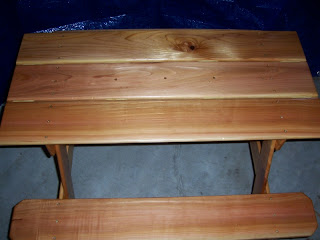The wood is aspen and cherry, the plans are from Toys and Joys. I used the SS to rip the the pieces to size with a planer blade, and the SS bandsaw for resawing (only had to do a little sanding on the sawed sufaces. Used my RAS to cut pieces to length, and a 10" band saw for the radius cuts. The truck is 16" long.
I choose aspen because I wanted a near white wood to contrast with the cherry, it works a lot like poplar.I did not keep tract of the time spent working on the truck I was doing other not so fun projects at the same time, but I think 8-10 hrs of actual time over a two week period.
Eric also made this model golf cart for his brother-in-law.
His cart is burgundy so using cherry was a no-brainer. The top is aspen, the bags are oak and the clubs are 1/8" dowel and basswood.


































